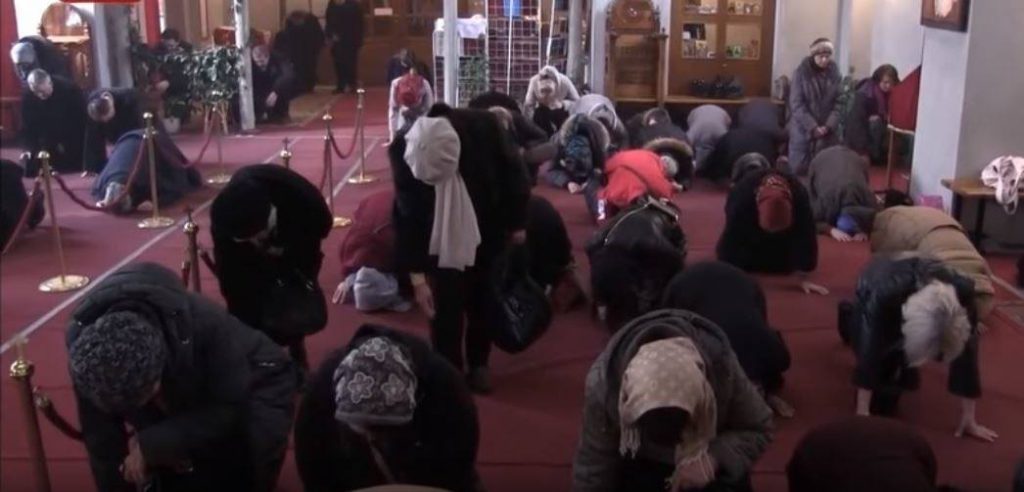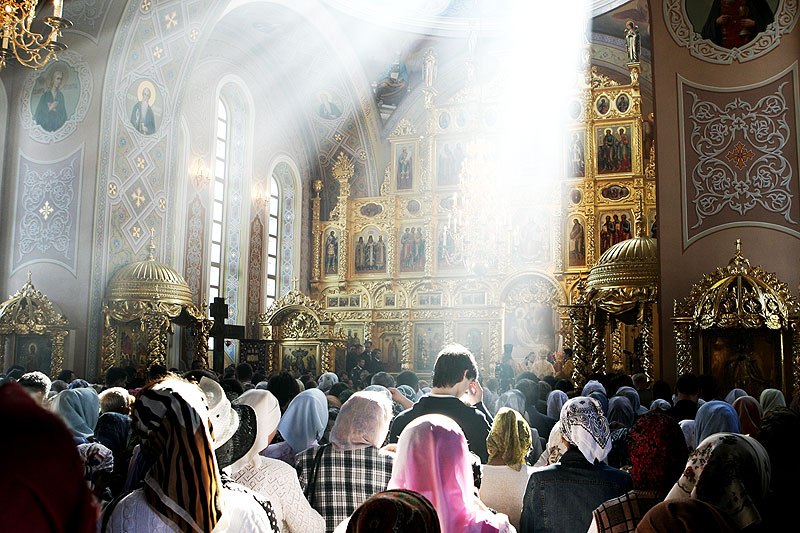More often than not, the faithful stand during services in the Orthodox Church. In fact, if you travel to “Orthodox countries” in Europe and the Middle East, you won’t find any pews at all! You may see a few chairs or benches scattered along the walls for the elderly, sick, infirm, and for pregnant and nursing mothers, but that’s it. Why do we stand so much? When is it okay to sit? And how do we know when to kneel, bow, or prostrate? Read on to find out!
Estimated reading time: 7 minutes
Table of contents
Why do we stand in Orthodox churches?
As Orthodox Christians, we stand during worship because that is how the Christian Church worshiped for nearly sixteen centuries. It wasn’t until the Protestant Reformation that the focus of Christian worship in the West changed from the Eucharist (communion) to the sermon. In Orthodox Tradition, we continue to stand as our predecessors did, maintaining the tradition set forth in Scripture (Isaiah 6:2; I Kings 22:19; Daniel 7:10; II Chronicles 5:12; 6:2; 20:5; I Ezra 3:10; Nehemiah 9:4-5; 8:7), professed by Christ Himself, and practiced by the early Church.
Remember: worshiping God is not about us. It is about Him. We are God’s humble servants. And we must be ready, attentive, and willing to serve Him. We must acknowledge that we are in the presence of God, and should stand in awe and respect. As Tertullian of Carthage tells us: “It is especially improper to pray while sitting at the very time that a multitude of angels stand before the face of the Lord in fear and trepidation; sitting shows that we are somehow praying unwillingly, carelessly, in a lazy manner.” We should stand for the entire service if we can physically manage to do so.
Is it okay to sit sometimes?
Of course it is! However, you need to think about the reason behind your sitting down. Is it because you have a health issue? Is it because of your age? Do you not know what’s going on and fear looking silly just standing there? Or is it simply because you don’t feel like standing all that time?
Because worship is all about God, we should should make every effort to stand as long as our bodies are able. If you do need to sit during the Divine Liturgy, remember to stand at these times:
- At the beginning when the priest gives the blessing
- During the Little and Great Entrances, Gospel reading, and Anaphora
- Whenever the priest is uses the censer
- While the congregation receives Holy Communion
- At the final blessing and Dismissal
In many parishes, service books in the pews or narthex may contain suggested times when you may sit. Whenever a hierarch (like a bishop or metropolitan) visits the parish, out of respect follow his example. Stand and sit when he does.
Bottom line? When in doubt, stand. You can never go wrong there!
Leg crossing
In modern American culture, we cross our legs a lot when sitting. Usually we do this to get more comfortable. When we get settled into our favorite chair at home, we lean back, cross our legs, and let our minds wander while we read, watch TV, or socialize. Is this sort of etiquette appropriate for church?
No. We refrain from crossing our legs because doing so is too casual and relaxed. Remember, we go to church to worship God, not to “hang out” like we do at a friend’s house. Remember, too, sitting in church is a concession of human weakness, not the norm for prayer or worship. Should we need to sit for health reasons, we must do so attentively, with our feet flat on the ground.
Do you ever kneel in an Orthodox church?
If you’ve ever visited a Roman Catholic church, you have probably seen “kneelers” attached to the pews. But in the Orthodox church, we typically do not kneel all that often.
In some Orthodox cultures, the faithful kneel during the Consecration of the Holy Gifts and other parts of the Liturgy. However, the Church Canons prohibit kneeling during the Paschal season (Pascha to Pentecost), and on Sundays. We consider kneeling penitential, and thus do not kneel on days or seasons celebrating the Resurrection of Our Lord.
Check out this article about kneeling practices in the Orthodox Church for more detailed information.
Using proper posture during worship
As we have said, in the Orthodox Church, worship is all about God. We gather together to give thanks, praise Him, and receive Him in the Eucharist. When we enter into the presence of our God, we should conduct ourselves respectfully, honoring Him with our dress, our behavior, and our posture.
Aside from standing, we use three other postures during worship in Orthodox churches: bows, metanias, and prostrations.
Bows
When we normally think of bowing, we imagine a full bow at the waist, nearly ninety degrees. The Orthodox deep/profound bow used in worship only goes about forty-five degrees. We often use it together with making the sign of the cross. This type of bow is also part of making a metania, which we’ll talk about soon.
While the Orthodox do use the profound bow at times, we more commonly use what we call a reverential bow. Rather than bowing at the waist, we simply incline the head and neck.
Orthodox Christians typically bow at the following times:
- When we pray to Christ or ask intercession of the Theotokos;
- As the priest blesses or censes the congregation;
- When the priests asks for forgiveness before the Great Entrance and before Holy Communion
Many Orthodox faithful bow and cross themselves when they enter and leave the nave of the church, and when they pray before icons. Some Orthodox may also cross themselves at the times we just listed above, but not all will do so. Deciding when to cross oneself is an issue of personal piety, not Orthodox dogma or doctrine.
Metanias
Metania comes from the Greek word metanoia (μετάνοια), which means “change of heart.” It goes by a few others names as well: lesser prostration, small bow, and little reverence, among others. We make metanias when asking for forgiveness and seeking repentance.
To perform a metania, first, you make the sign of the cross. Then, bending at your waist, reach toward the floor with your right hand and touch the ground. Orthodox Christians perform metanias regularly; for example, during the refrains of Akathists, when venerating icons, and when approaching the chalice for Holy Communion. We also use it as a sort of substitute for the prostration, which the Church Canons only permit on certain occasions.
Prostrations
You may also hear some Orthodox refer to the prostration as a greater prostration, proskynesis (Greek προσκυνήσις), full bow, or great metania. Similar to the metania, we associate this gesture with penance and submission.

To perform a prostration, you get down on your hands and knees, then touch your forehead to the floor and remain there as long as you desire. The motion is similar to the Chinese kowtow. Most people hold the position for a few seconds, long enough to say the Jesus Prayer. Some cross themselves before doing the prostration, while others cross themselves after standing back up. Those who can’t perform prostrations for physical reasons may do metanias instead, as seen in the picture above.
According to Holy Tradition, there are times when it is and is not acceptable to perform prostrations during worship. We do not kneel or prostrate on Sundays or during the Paschal season (the fifty days between Pascha and Pentecost. However, the guidelines don’t stop there.
Worship is work!
Worship is not a time of relaxation. It is not a time to lean back and just listen. Rather, it is a time to do the common work of worshiping and thanking God. The Orthodox, unlike Western Christians, worship with our entire bodies, not just our minds. This is why you see so much movement during an Orthodox service that just seems to flow without any effort at all. People bow, prostrate, cross themselves, move about to venerate icons or kiss the cross. The priest and deacons and altar servers move about, the choir sings while others pray. So much is happening, it is actually quite mesmerizing to watch.
The next time you visit an Orthodox parish, take a moment to absorb this. The beauty of the common work is a true testament to your being in Heaven on Earth.
Keep Reading: 8 Things To Expect In An Orthodox Church

